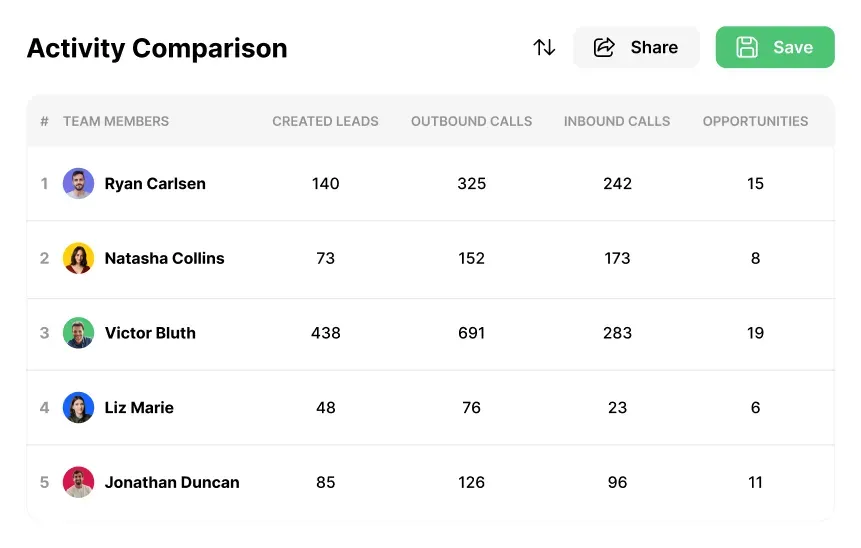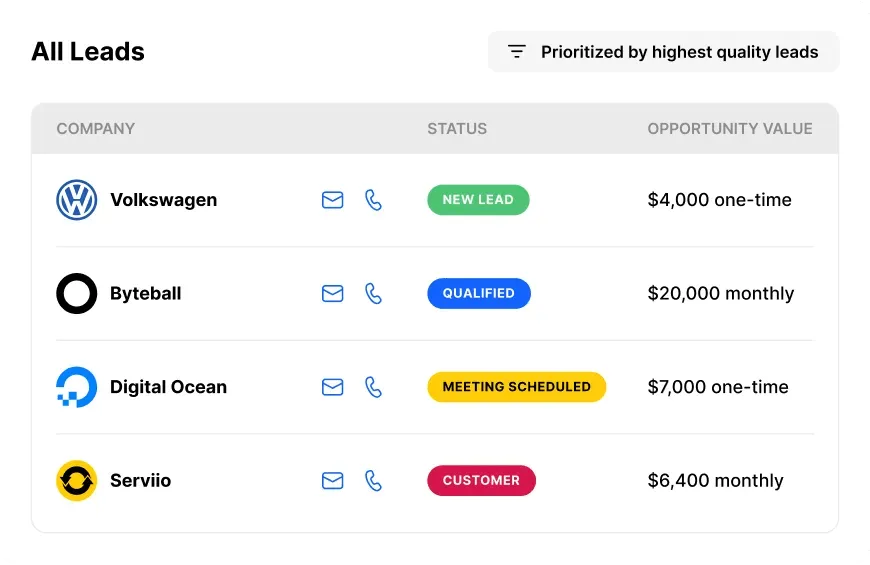
MQL or SQL? That is the question many new marketers and salespeople ask. As a key part of your qualification process and inbound marketing strategy, it’s important to know the answer.
In this article, we’ll teach you everything you need to know about MQLs and SQLs, how to determine which leads should be MQLs or SQLs, and provide tips on how to convert more MQLs into SQLs and the sales pipeline.
We’ll kick things off with the beginning of the journey (MQLs) and then move down the funnel later on (SQLs).
What Is a Marketing Qualified Lead (MQL)?
An MQL kicks off the funnel after lead generation in a typical sales funnel. It’s the beginning stage at which new leads enter the funnel. Here, we’ll go through how MQLs are defined and identified, plus explore some examples of typical MQLs.
What Is the Definition of MQL in Sales?
Once they’ve indicated a higher level of interest through engagement, which increases their lead score, they may receive a call from a sales rep. If they show an interest in buying after that sales call, they move on to the next stage of the funnel, sales qualified lead (SQL).
How to Identify MQLs
MQLs are identified by showing interest in something related to your offering. Typically, this is done through a piece of content you’ve published and put behind a "gate" or call-to-action (CTA) that requires people to enter their name, company, email, and phone number to download. The content could be a useful guide, a case study, an on-demand webinar, or anything relevant to your company.
MQLs can also be identified by other forms, such as signing up for a newsletter. Usually, when a "contact sales" form is filled out, it indicates a higher level of interest, so instead of becoming an MQL, they go straight to SQL and get a call from a salesperson, skipping the marketing funnel altogether.
What Are the Characteristics of MQLs?
Some first-time visitors that don’t fit your MQL profile may download a piece of content. They may just have wanted the whitepaper and to be left alone. Using your lead scoring tool in your customer relationship management (CRM) system, you can use the following characteristics to determine if someone has a high enough score to be considered an MQL and placed into your funnel:
- Engagement: If someone downloads something one time and then never engages with your site again, they may not be interested. However, users who repeatedly engage with your site, content, email, and social media should be considered MQLs.
- Ideal Customer Profile (ICP) match: Use your ideal customer profile and buyer personas to judge whether or not someone is a fit. Ideally, these are the people you wrote the content for, so they should be the ones downloading it. However, you may get people such as writers doing research, spies who work for rival companies trying to get an inside scoop, or other non-relevant users downloading your stuff.
 |
Industry, company, company size, job title, and other demographics can be used to determine if someone should be considered an MQL. While you don’t want to overload people, it’s helpful to require them to fill out some of this info so you can better determine their fit before you enroll them in a marketing campaign.
- Frequency and recency: Within your engagement tracking, it’s helpful to track how frequently and recently a user has interacted with your brand. If you’ve sent dozens of emails with no opens, you may no longer be an MQL or perhaps have moved to a new job. The more frequently and recently someone interacts with your content, the higher likelihood of converting to an SQL or customer.
- Lead score: Within your CRM, you should have an automated lead scoring system. For example, if someone downloads a report, they might automatically be given a lead score of "100," the base level for being an MQL, so they are enrolled in your email marketing campaign for new MQLs. Later on, they open and click on enough emails to get to a lead score of "300," which turns them into an SQL, so they get a call from a salesperson. You don’t have to only use engagement to determine a lead score. You can also use demographics such as industry, job title, and any other information you collect.
 |
→ MQL? SQL? Lead Score? ICP? If these terms have your head spinning, check out and bookmark our sales terms glossary so you’re always in the know.
What Are Examples of MQLs?
Depending on how you interact with your potential customers, you might encounter several different types of MQLs. Some typical examples include:
- Content downloaders: Probably the most common type of MQL, they’ve downloaded a piece of helpful content, indicating that they’re a likely match for your solutions.
- Webinar attendees: These people found value in your latest webinar, which shows a strong sign they are a good potential fit. You can enroll them in a "webinar-specific" marketing campaign that goes deeper into the webinar’s topic.
- Free trial users: Many software companies allow people to poke around in a limited version of their product before purchasing. These people are definitely MQLs, if not SQLs, since trying the product indicates a high level of interest.
- Newsletter subscribers: Not all newsletter subscribers are MQLs, but some are. Those who frequently engage with your emails and fit your ideal customer profile should be seen as MQLs.
- Trade show contacts: Some companies will go to trade shows and collect people’s info with free giveaways at the booth or through the attendee registry. While perhaps most of these people won’t be MQLs in the end, some will (which is why companies spend so much money trying to impress people at trade shows).
What Is a Sales Qualified Lead (SQL)?
Once an MQL has shown a certain level of interest and engagement, they become an SQL. Now, they will be engaged by the sales team and taken through the lower steps of the funnel. Below, we’ll give you everything you need to know about SQLs.
What Is the Definition of SQL in Sales?
Once they cross the threshold into SQL territory, a salesperson will reach out to officially qualify them for an opportunity or deal. During this process, the salesperson will try to understand:
- The fit between needs and the product or service being offered
- The timeline for purchase
- The size of the potential deal
- The prospect's budget
After the qualification stage, the SQL will move into the decision stage, where there will be more calls, demos, and follow-up emails that vary based on the typical sales sequence for a given company.
How Are SQLs Identified?
Marketing and sales teams need an established system to identify when leads go from an MQL to an SQL. Once an SQL has revealed itself in the CRM, sales reps can strike while the iron’s hot.
Most teams use these tools to identify SQLs:
- Lead scoring: Just like with MQLs, lead scoring identifies when a lead turns into an SQL. Using a score based on factors such as demographic fit (job title, company size, etc.), and engagement (form fills, viewing sales content, etc.), you can set a threshold for when a lead turns to an SQL and is worthy of being contacted by sales.
- Website behavior analysis: While this rolls up into lead scoring, you can watch for actions such as viewing the pricing page and product pages several times as an indicator that a lead is ready to become an SQL.
- Direct communication: SQLs may identify themselves by filling out a form on your site or chatting with your website’s chatbot. There, they can state their questions and needs, and give more than enough information to warrant becoming an SQL.
- Sales collateral engagement: Also wrapped up with lead scoring, watching how many clicks you get on sales materials (demos, digital brochures, decks, etc) is another strong indicator that a lead is ready for the SQL stage of the funnel.
What Are the Characteristics of Quality SQLs?
By the time someone reaches the SQL stage, they will most likely be a strong yes or a hard no for your offering. Quality SQLs usually have the same common characteristics that poorly matched SQLs lack.
To identify quality SQLs, look for the following:
- Strong buying signals: Quality SQLs want to buy your product or learn more about it. They will ask for a quote, a demo, pricing details, and their specific requirements. This opportunity is your chance to show that you’re the right fit (along with the requested details).
- High engagement: SQLs that consume and share your marketing and sales materials, ask questions during a product demo, and actively use a free trial are the most likely to want to actually buy.
- The right pain points: SQLs with the exact pain point your product was designed to solve are (obviously) better than those that don’t have that problem. Make sure they clearly understand what that pain point is and how you best solve it.
- Decision-maker status: SQLs without the power to buy will have to bring more people in to make a decision, which will lengthen the sales process and open the door to rejection from others involved. If you can get in with the decision-maker, you’re in a much better spot.
- Ideal customer profile (ICP) fit: If someone fits the ICP or buyer persona that you designed for your product, there’s a really good chance they’ll have the problems that you can solve best. If they’re way off, they might not be a qualified fit.
What Are Examples of SQLs?
Most SQLs will fall under several typical buckets, but not all. Some of the most common types of SQLs I’ve seen fall into these categories:
- Demo requesters: Actively requesting a demo is one of the quickest ways to become an SQL. It indicates strong interest and gives the salesperson a chance to customize a demo to their specific needs.
- Pricing askers: Lots of SQLs will come right out of the gate asking about pricing. This can indicate a strong interest (if they’re not scared off by the price) and shows they’re serious about buying.
- Meeting lovers: Some people just need to discuss things over the phone or Zoom; an email just can’t cut it. When an SQL requests a meeting, you’re in a good position to find out their exact needs and move them down the sales funnel.
- Solution seekers: Many SQLs are just looking to solve a problem, and you are the one they found when seeking that solution. If your marketing team has done its job well, you’re in a great position to fill that need.
- Referral-ees: If your product has raving fans, you’ll likely get an influx of other people coming your way who want that same goodness. Make sure you ask your superstars for referrals occasionally to keep that pipeline strong.
3 Key Differences Between MQLs and SQLs
Now that you have a thorough understanding of both MQLs and SQLs, let’s go into some of the differences between the two so you’re better equipped to categorize them in your CRM and lead scoring system.
These are the three key differences you should consider when creating a system in your CRM that determines who is an MQL or SQL.
- Engagement level: MQLs show some engagement with your brand by downloading or filling out a form. SQLs express strong interest in your offering by requesting a product demo, reaching out to your sales team, or engaging with your content so often that their lead score puts them in SQL territory.
- Lead score: Your lead score system should definitively tell who is an MQL or SQL. Certain activities like clicking on an email or viewing the product page will increase their score. If that score exceeds a certain threshold, they become an SQL.
- Buyer’s journey stage: Generally, MQLs will be much earlier in the buyer’s journey than MQLs. They are still in the exploration stage, while SQLs are in the decision-making stage.
 |
3 Tips for Turning MQLs into SQLs (and Beyond!)
It’s time to get those lead scores up! MQL to SQL conversion rate is the name of the game for marketing departments. This opportunity is one of the main ways you contribute to the pipeline and impress the sales team plus the people upstairs.
In your marketing efforts, follow these three tips for converting more MQLs into SQLs, which will then convert into customers and moolah for your company.
- Personalized nurturing: Use the persona and demographic information you get from MQLs to create personalized messaging. Each MQL has unique needs, preferences, and pain points. Get as personal as possible within your ICPs and persona to speak to those needs.
- High-quality content: The worst is when you download a piece of content from a company you’re interested in, and it provides no value or gives bad advice. Helpful, engaging, and valuable content shows MQLs you understand their needs. High-quality content inspires leads to want to take the action that converts them to an SQL.
- Consistent engagement: Don’t sleep on your MQLs. They will probably forget you exist. Consistent touchpoints through email or targeted ads can build trust, maintain awareness, and keep leads in the loop. The more you engage, the more likely they convert to an SQL.
The journey from MQL to SQL is a crucial component of your marketing strategy, so make the most of it.
To better visualize and manage this journey, consider using tools like Close's Sales Funnel Calculator. This tool can help you understand how leads move through your funnel, aiding in optimizing your strategies for both MQLs and SQLs.
Use the Full Power of Your CRM for the MQL to SQL Journey
Your CRM software is a powerful tool for managing MQLs and SQLs through the handoff process and beyond. You’re able to track so many useful lead behavior metrics, such as how many times someone visits a landing page.
Setting up your CRM for the best qualifying and lead nurturing experience for new MQLs is crucial for your business. It will inform you of new leads, their behavior, and when they’re ready for a real conversation. You can use it carefully to craft a journey for prospective customers to make informed purchasing decisions.
From digital marketing to sales strategy, your CRM is probably your most important tool.
Learn more about how the Close CRM system can help you exceed your MQL to SQL conversion targets through advanced automation and lead qualification tools.










